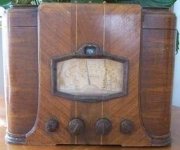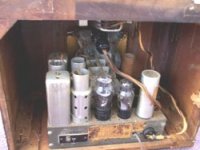My uncle gave me his 1936 Sears Silvertone radio this past weekend, so i'm restoring it currently.
3 of its tubes have those plugs attached to the top of them. My question is what were those for? Why did tubes have a plug coming out of the top, and couldn't this have been moved to another pin on the bottom?
pics of the radio so you can see what i'm working on:
3 of its tubes have those plugs attached to the top of them. My question is what were those for? Why did tubes have a plug coming out of the top, and couldn't this have been moved to another pin on the bottom?
pics of the radio so you can see what i'm working on:
Attachments
Nice looking set
In answer to the first part of the question, the top caps for the frequency changer, IF amplifier and the first audio amplifier (usually a double diode triode) are the signal grid connections.
I don't really know that answer to the second part - I'd hazard a guess that it was due to the state of the construction technology available at the time which made it easier to use top caps, and possibly it was an attempt to avoid instability to have the signal grid well separated from the connections for the other parts of the tube.
With a frequency changer tube, which normally was a triode-hexode, triode-heptode or octode tube, you could run out of pins on the bottom of the tube anyway for all the connections you need!
In answer to the first part of the question, the top caps for the frequency changer, IF amplifier and the first audio amplifier (usually a double diode triode) are the signal grid connections.
I don't really know that answer to the second part - I'd hazard a guess that it was due to the state of the construction technology available at the time which made it easier to use top caps, and possibly it was an attempt to avoid instability to have the signal grid well separated from the connections for the other parts of the tube.
With a frequency changer tube, which normally was a triode-hexode, triode-heptode or octode tube, you could run out of pins on the bottom of the tube anyway for all the connections you need!
That's one terrific looking radio, Magnetmaz!!
Three cheers to you for taking the time to restore it, too! I always feel ill when I hear of someone trashing a lovely old radio like that, so it's good to see that there are people like you taking care of the classics.....
All the best,
Morse
Three cheers to you for taking the time to restore it, too! I always feel ill when I hear of someone trashing a lovely old radio like that, so it's good to see that there are people like you taking care of the classics.....
All the best,
Morse
Magnetmaz,
In case you haven't seen them yet, there are some schematics for old Sears sets located at:
http://www.nostalgiaair.org/NostalgiaAir/Schematics/schem_SRC.htm
With a bit of luck your set will be amongst them.
Good luck with the restoration.
In case you haven't seen them yet, there are some schematics for old Sears sets located at:
http://www.nostalgiaair.org/NostalgiaAir/Schematics/schem_SRC.htm
With a bit of luck your set will be amongst them.
Good luck with the restoration.
- Status
- This old topic is closed. If you want to reopen this topic, contact a moderator using the "Report Post" button.
- Home
- Amplifiers
- Tubes / Valves
- Another tube radio

